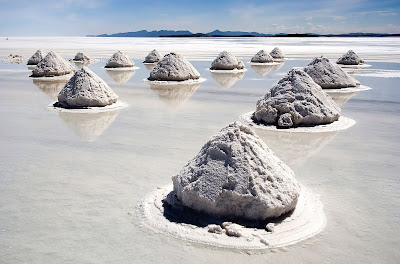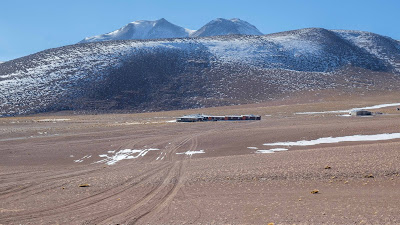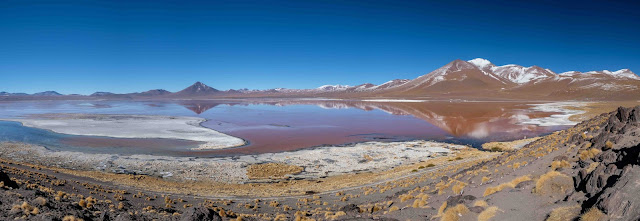Well… what follows are descriptions of the final 3 days of travelling through Bolivia and we hopefully have left the best for last, considering we rate these 3 days amongst the list of main highlights of our entire trip within South America.
During these 3 days we also took the largest number of hand held panorama photos ever taken on any trip anywhere in the world, one for example involving 17 individual photos which were then stitched together.
So apologies for possibly too many larger landscape photos in this post.
So lets try to explain what these 3 days consisted of after leaving Uyuni and heading mainly south towards the border with Chile.
For a start we travelled the entire time in a 4WD with our Bolivian driver Luis, who spoke only a little English. We travelled ~548 kms with roughly 95% of it off road and at altitudes ranging between ~3,600m to 5,000m through the Bolivian Andes mountains.
The map below shows our actual route after leaving Uyuni and wandering into the wilderness.
Day 1. – Salar de Uyuni (Uyuni Salt Flats)
After meeting Luis and loading our gear into the 4WD, first stop on the outskirts of Uyuni was a train graveyard full of rusting steam engines
 |
| Old trains... trains everywhere |
Before reaching the salar (salt flat) proper, we made a brief stop at the salt museum, detailing the mining of salt over many years and then reached the edge of the salt flat, where we were stopped by a 4WD that had already got into trouble.
 |
| How they still mine salt on the salar (Photo courtesy of Luca Galuzzi) |
This salar is the largest on the planet at roughly 10,500 square kilometres in area and used periodically for some of the famous Dakar off-road races. To put this into perspective, the famous Bonnevile Salt Flats are a mere 104 square kilometres.
 |
| Recognition in salt to the Dakar event |
 |
| The salar is simply massive |
Some of the dark shapes in the distance were other 4WDs also travelling west, or coming towards us, but other dark shapes were either mountains or islands located on the salar itself.
Remember all the snow that had fallen in Potosi? Well it had also fallen for many days longer over the salt flat and had now melted, leaving a lot of water we began driving through and something Luis kept muttering, “not normal, not normal”.
Remember all the snow that had fallen in Potosi? Well it had also fallen for many days longer over the salt flat and had now melted, leaving a lot of water we began driving through and something Luis kept muttering, “not normal, not normal”.
Slowly but surely, as we progressed across the flat, we started driving through water lying on its surface, at first a few puddles but eventually consistently about 6-7cms deep across the entire surface in any direction we looked.
 |
| The water on the surface of the salar starting to increase with Tunupa volcano in the background |
We were a little lucky to be driven by Luis after noticing something on his arm and asking, “tattoo” to which he responded, “me Bolivian navy… Lake Titicaca”, so he was at least used to being on water. It was quite a surreal experience because it felt like we were sailing on a massive lake but in a 4WD.
After a few hours of progress Luis stopped on a small circular ‘island’ of salt about 10m in diameter and 3-4 cms above the water level and exclaimed simply, “lunch”.
With that Luis started setting up a small table with tablecloth, some chairs retrieved from the car’s roof, china plates, cooked lama, chorizo sausage, potatoes, quinoa, avocado, tomato and drinks.
 |
| Luis setting up for lunch on a small salt island on a salt flat... no lake... no salt flat... |
 |
| ...and enjoying it! |
There we sat on our tiny salt island, clear blue sky, an occasional 4WD passing by on the horizon, an eerie silence returning whilst having a lovely lunch. Unbelievable!
 |
| Another car 'sailing' by during lunch |
We also learned after reaching Chile, salar Uyuni also contains 50-70% of the world’s lithium in the brine water below the salt surface, a massive opportunity for Bolivia if they can both extract and export it.
Lunch completed, on we drove and it was getting warmer in the car and Luis seemingly started nodding off briefly to sleep. I was in the front seat with him but didn’t do anything when it happened because we were going slowly and there was nothing for us to hit anyway! He always woke up and corrected course a little, then started chewing coca leaves to give him extra energy.
We had been heading towards one of those dark shapes on the horizon for hours, Luis telling us, “Isla de Pescado” (Fish Island) which finally we reached and drove round to the back of it… OMG! There were lots of 4WDs parked, a restaurant, shops and toilets.
 |
| Other 4WDs parked at the island in the salar |
 |
| Rob standing next to a tall cactus |
 |
| View from the island, 4WD driving on the salar and Tunupa volcano in the distance |
 |
| It was hard to tire of this view |
 |
| Other tourists enjoying themselves on the watery surface of the salar |
 |
| Luis pumping up a tyre before we leave the water and salt |
 |
| Tunupa volcano and its reflection... the small black dot in the middle of the photo is a 4WD |
Day 2. - Into The Desert
After leaving the hotel we ventured on, detouring briefly to have a look at a very small ghost village used by the Bolivians to hide in during the last big war with Chile. They lived there for 20 yrs without ever being found and returned eventually to the village we had stayed in the previous night.
 |
| Deserted village which saved hundreds of Bolivians during the war with Chile |
 |
| We drive out across the Chiguana salt flat |
 |
| In the distance stand multiple volcanos |
 |
| Railway to seemingly nowhere |
 |
| Going overland looking for a volcano |
 |
| Ollague volcano smoking in the distance |
 |
| Lunch by the lake |
 |
| Flamingos with their stunning backdrop |
 |
| Graceful flamingo on the wing |
To progress further, we found ourselves driving through an area called Inca Gorge, because of how thousands of large rocks are stacked atop each other to form the gorge wall itself. Within the gorge lives the mountain viscacha, a rodent closely related to chinchilla with a long tail looking a little like a rabbit kangaroo to us.
We emerged out of the gorge and started our drive across part of the Siloli Desert where we also came upon an Andean fox gorging itself on something, unbothered by our presence, food being its priority in this tree and grassless environment.
Now at over 4,800m altitude, in the distance we saw, then finally reached our accommodation for the night, the very remote Tayka del Desierto Hotel. During check-in, we were told we had to have showers that night because there would be any hot water next morning or heaters, which also were only used from 5:30-10:00pm each day!
 |
| Lots of open space and no real track on the Siloli desert |
The hotel was full of tourists and the restaurant we all descended on, was actually very well run and provided excellent food, despite its remoteness.
 |
| The very remote and high Tayka del Desierto Hotel |
Day 3. – More lakes and desert until Chile
The sun rose on our final day in Bolivia around 6:30am, and at the altitude we were at, it was a bit chilly inside the hotel as we enjoyed breakfast before leaving around 8:00am.
Why is this important… well when we departed and after 1.5hrs of sunshine, the outside temperature had reached -12c, yes minus12c as we drove off back into the Eduardo Avaroa National Park looking for the ‘Stone Tree’ which we found about 1 hr later.
There is a single massive rock, sort of shaped like a tree, standing with other very large rock formations in the middle of no-where, apart from of course, mountains in the distance.
 |
| The 'Stone Tree' |
 |
| More of the stone structures in the Eduardo Avaroa National Park |
 |
| The captivating Laguna Colorada |
 |
| Steam rising from the 'Red Lagoon' and flamingos enjoying the warm water |
Almost got bogged in snow and mud in one section as we nudged 5,000m before reaching the geysers, including bubbling mud and steam escaping from various orifices, along with that 'wonderful' smell of sulphur.
 |
| Geysers and hot bubbling mud at nearly 5,000m |
On our way towards the border with Chile we briefly stopped at some thermal hot springs set next to yet another lagoon, tourists enjoying a relaxing bath in them. We didn't stay however because we were on a tight schedule to meet a transfer at the border.
The drive just kept on being stunning as we constantly asked Luis to stop for yet another picture, in fact he got very good at reading the signs when either one of us started fidgeting with our cameras.
This part of Bolivia has an abundance of volcanoes, but one called Licancabur was particularly impressive near the border with Chile. As we got closer to it, and after multiple stops to take photos of it, we passed the White Lagoon, given its name because its usually frozen, then soon after, came over a ridge and Licancabur stood there in front of us.
 |
| Yet another landscape to photograph as we near the border with Chile |
In front of Licancabur keeping it company was Laguna Verde or the Green Lagoon, which itself was surrounded by snow and ice mixed, with brown rocks and soil… yet again, breathtaking!
 |
| Licancabur volcano behind the 'Green 'Lagoon' |
 |
| Driving around the 'Green Lagoon' to reach the Chilean border |
Finally we reached the Bolivian Immigration control located in a little wind blown, cold ramshackle rock hut, where after stamping our passports and holding onto them, the officer asked us for 30 Bolivianos to leave the country.
 |
| Desolate lifestyle near the border |
We do not do this very often but at this point would really like to commend Paprika Tours based in Peru for organising a very smooth, enjoyable and tailored tour for us through both Peru and Boliva.
Everything happened as planned and the minor issues which always happen, were very promptly resolved. Impressive indeed Paprika Tours.
We had just finished 3 truly remarkable days to complete our journey within Bolivia when collected by the transport into Chile and after saying our final farewells to Luis, headed to the Chilean border and whatever would come next.
As always… go well!











Amazing scenery...
ReplyDelete